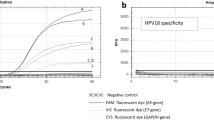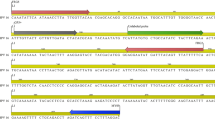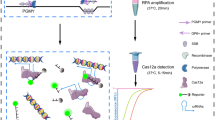Abstract
Quantitative PCR with hybridization probes allows the reliable quantification of viral DNA sequences in clinical samples with a dynamic range and sensitivity that cannot be achieved with other methods. The technical background for the establishment of protocols is described and established protocols are presented to estimate the viral load per cell of frequently occurring betapapillomaviruses (HPV5, -8, -15, -20, -23, -24, -36 and -38) in skin tumors, healthy skin and hair bulbs. This approach accurately adjusts dilution series of reference DNA of different viral types relative to pUC18, which is crucial for comparative analyses and for interlaboratory standardization. The type-specific determination of beta-HPV DNA loads is an important research tool toward discrimination between low-level persistence and activated possibly pathologically relevant infections. The analysis of 24 samples, starting with DNA extraction and followed by HPV typing and quantification of—on average—three of the described HPV types takes about 2 d.
This is a preview of subscription content, access via your institution
Access options
Subscribe to this journal
Receive 12 print issues and online access
$259.00 per year
only $21.58 per issue
Buy this article
- Purchase on Springer Link
- Instant access to full article PDF
Prices may be subject to local taxes which are calculated during checkout



Similar content being viewed by others
References
IARC. Human papillomaviruses. IARC Monogr. Eval. Carcinog. Risks Hum. 90, 245–259 (2007).
Orth, G. Genetics of epidermodysplasia verruciformis: insights into host defense against papillomaviruses. Semin. Immunol. 18, 362–74 (2006).
Berkhout, R.J. et al. Nested PCR approach for detection and typing of epidermodysplasia verruciformis-associated human papillomavirus types in cutaneous cancers from renal transplant recipients. J. Clin. Microbiol. 33, 690–695 (1995).
Forslund, O., Antonsson, A., Nordin, P., Stenquist, B. & Hansson, B.G. A broad range of human papillomavirus types detected with a general PCR method suitable for analysis of cutaneous tumours and normal skin. J. Gen. Virol. 80 (Part 9): 2437–2443 (1999).
Pfister, H. et al. High prevalence of epidermodysplasia verruciformis-associated human papillomavirus DNA in actinic keratoses of the immunocompetent population. Arch Dermatol. Res. 295, 273–279 (2003).
Shamanin, V. et al. Human papillomavirus infections in nonmelanoma skin cancers from renal transplant recipients and nonimmunosuppressed patients. J. Natl. Cancer Inst. 88, 802–811 (1996).
Boxman, I.L. et al. Detection of human papillomavirus DNA in plucked hairs from renal transplant recipients and healthy volunteers. J. Invest. Dermatol. 108, 712–715 (1997).
Antonsson, A., Forslund, O., Ekberg, H., Sterner, G. & Hansson, B.G. The ubiquity and impressive genomic diversity of human skin papillomaviruses suggest a commensalic nature of these viruses. J. Virol. 74, 11636–11641 (2000).
Astori, G. et al. Human papillomaviruses are commonly found in normal skin of immunocompetent hosts. J. Invest. Dermatol. 110, 752–755 (1998).
Weissenborn, S.J., De Koning, M.N., Wieland, U., Quint, W.G. & Pfister, H.J. Intrafamilial transmission and family-specific spectra of cutaneous betapapillomaviruses. J. Virol. 83, 811–816 (2009).
Antonsson, A., Karanfilovska, S., Lindqvist, P.G. & Hansson, B.G. General acquisition of human papillomavirus infections of skin occurs in early infancy. J. Clin. Microbiol. 41, 2509–2514 (2003).
Hazard, K. et al. Cutaneous human papillomaviruses persist on healthy skin. J. Invest. Dermatol. 127, 116–119 (2007).
de Koning, M.N. et al. Betapapillomaviruses frequently persist in the skin of healthy individuals. J. Gen. Virol. 88, 1489–1495 (2007).
de Koning, M.N. et al. Prevalence and associated factors of betapapillomavirus infections in individuals without cutaneous squamous cell carcinoma. J. Gen. Virol. 90, 1611–1621 (2009).
Harwood, C.A. et al. Increased risk of skin cancer associated with the presence of epidermodysplasia verruciformis human papillomavirus types in normal skin. Br. J. Dermatol. 150, 949–957 (2004).
Struijk, L. et al. Presence of human papillomavirus DNA in plucked eyebrow hairs is associated with a history of cutaneous squamous cell carcinoma. J. Invest. Dermatol. 121, 1531–1535 (2003).
Boxman, I.L. et al. Case–control study in a subtropical Australian population to assess the relation between non-melanoma skin cancer and epidermodysplasia verruciformis human papillomavirus DNA in plucked eyebrow hairs. The Nambour Skin Cancer Prevention Study Group. Int. J. Cancer 86, 118–121 (2000).
Iftner, A. et al. The prevalence of human papillomavirus genotypes in nonmelanoma skin cancers of nonimmunosuppressed individuals identifies high-risk genital types as possible risk factors. Cancer Res. 63, 7515–7519 (2003).
Asgari, M.M. et al. Detection of human papillomavirus DNA in cutaneous squamous cell carcinoma among immunocompetent individuals. J. Invest. Dermatol. 128, 1409–1417 (2008).
Weissenborn, S.J. et al. Human papillomavirus-DNA loads in actinic keratoses exceed those in non-melanoma skin cancers. J. Invest. Dermatol. 125, 93–97 (2005).
Dell'Oste, V. et al. High beta-HPV DNA loads and strong seroreactivity are present in epidermodysplasia verruciformis. J. Invest. Dermatol. 129, 1026–1034 (2009).
Brink, A.A. et al. Development of a general-primer-PCR-reverse-line-blotting system for detection of beta and gamma cutaneous human papillomaviruses. J. Clin. Microbiol. 43, 5581–5587 (2005).
de Koning, M. et al. Evaluation of a novel highly sensitive, broad-spectrum PCR-reverse hybridization assay for detection and identification of beta-papillomavirus DNA. J. Clin. Microbiol. 44, 1792–1800 (2006).
Nindl, I. et al. Extension of the typing in a general-primer-PCR reverse-line-blotting system to detect all 25 cutaneous beta human papillomaviruses. J. Virol. Methods 146, 1–4 (2007).
Gheit, T. et al. Development of a sensitive and specific multiplex PCR method combined with DNA microarray primer extension to detect betapapillomavirus types. J. Clin. Microbiol. 45, 2537–2544 (2007).
Malnati, M.S. et al. A universal real-time PCR assay for the quantification of group-M HIV-1 proviral load. Nat. Protoc. 3, 1240–1248 (2008).
Kubista, M. et al. The real-time polymerase chain reaction. Mol. Aspects Med. 27, 95–125 (2006).
Kreuter, A. et al. Penile intraepithelial neoplasia is frequent in HIV-positive men with anal dysplasia. J. Invest. Dermatol. 128, 2316–2324 (2008).
Vasiljevic, N. et al. Characterization of two novel cutaneous human papillomaviruses, HPV93 and HPV96. J. Gen. Virol. 88, 1479–1483 (2007).
Vasiljevic, N., Hazard, K., Dillner, J. & Forslund, O. Four novel human betapapillomaviruses of species 2 preferentially found in actinic keratosis. J. Gen. Virol. 89, 2467–2474 (2008).
Sutcliffe, J.G. Nucleotide sequence of the ampicillin resistance gene of Escherichia coli plasmid pBR322. Proc. Natl. Acad. Sci. USA 75, 3737–3741 (1978).
Kwok, S. Procedures to minimize PCR-product carry-over. In PCR Protocols—A guide to Methods and Applications (eds. Innis, M.A., Gelfand, D.H., Sninsky, J.J. & White, T.J.) 142–145 (Academic Press, San Diego, California, 1990).
Kwok, S. & Higuchi, R. Avoiding false positives with PCR. Nature 339, 237–238 (1989).
Wittwer, T.C. et al. Continuous fluorescence monitoring of rapid cycle DNA amplification. BioTechniques 22, 130–138 (1997).
Wittwer, T.C. et al. The LightCycler: a microvolume multisample fluorimeter with rapid temperature control. BioTechniques 22, 176–181 (1997).
Mackay, J. & Landt, O. Real-time PCR fluorescent chemistries. In Protocols for Nucleic Acid Analysis by Nonradioactive Probes 2nd edn. Vol. 353 (eds. Hilario, E.& Mackay, J.) 237–261 (Humana Press, Clifton, New Jersey, 2007).
Korbie, D.J. & Mattick, J.S. Touchdown PCR for increased specificity and sensitivity in PCR amplification. Nat. Protoc. 3, 1452–1456 (2008).
Weissenborn, S.J. et al. Oncogenic human papillomavirus DNA loads in human immunodeficiency virus-positive women with high-grade cervical lesions are strongly elevated. J. Clin. Microbiol. 41, 2763–2767 (2003).
Sambrook, J. & Russell, D.W. Molecular Cloning (Cold Spring Harbor Laboratory, Cold Spring Harbor, New York, 2001).
Kremsdorf, D., Jablonska, S., Favre, M. & Orth, G. Biochemical characterization of two types of human papillomaviruses associated with epidermodysplasia verruciformis. J. Virol. 43, 436–447 (1982).
Pfister, H., Nürnberger, F., Gissmann, L. & zur Hausen, H. Characterization of a human papillomavirus from epidermodysplasia verruciformis lesions of a patient from Upper-volta. Int. J. Cancer 27, 645–650 (1981).
Steger, G., Olszewsky, M., Stockfleth, E. & Pfister, H. Prevalence of antibodies to human papillomavirus type 8 in human sera. J. Virol. 64, 4399–4406 (1990).
Kremsdorf, D. et al. Molecular cloning and characterization of the genomes of nine newly recognized human papillomavirus types associated with epidermodysplasia verruciformis. J. Virol. 52, 1013–1018 (1984).
Kawashima, M., Favre, M., Jablonska, S., Obalek, S. & Orth, G. Characterization of a new type of human papillomavirus (HPV) related to HPV5 from a case of actinic keratosis. Virology 154, 389–394 (1986).
Scheurlen, W., Gissmann, L., Gross, G. & zur Hausen, H. Molecular cloning of two new HPV types (HPV 37 and HPV 38) from a keratoacanthoma and a malignant melanoma. Int. J. Cancer 37, 505–510 (1986).
Wieland, U. et al. Communication: papillomavirus DNA in basal cell carcinomas of immunocompetent patients: an accidental association? J. Invest. Dermatol. 115, 124–128 (2000).
Saiki, R.K. et al. Enzymatic amplification of beta-globin genomic sequences and restriction site analysis for diagnosis of sickle cell anemia. Science 230, 1350–1354 (1985).
Acknowledgements
This study was supported by EC Grant QLK-CT-200201179. S.J.W. is supported by the 'Deutsche Krebshilfe,' EMBO and the Köln Fortune Program of the University of Cologne. U.W. was supported by the German Federal Ministry of Education and Research (BMBF) (Grant no. 01 KI 0771 (TP7)).
AUTHOR CONTRIBUTIONS
S.J.W. conceived and designed the protocol; S.J.W., M.J., U.W. and H.P. provided administrative, technical or material support; and S.J.W., U.W. and H.P. wrote the paper.
Author information
Authors and Affiliations
Corresponding author
Rights and permissions
About this article
Cite this article
Weissenborn, S., Wieland, U., Junk, M. et al. Quantification of beta-human papillomavirus DNA by real-time PCR. Nat Protoc 5, 1–13 (2010). https://doi.org/10.1038/nprot.2009.153
Published:
Issue Date:
DOI: https://doi.org/10.1038/nprot.2009.153
This article is cited by
-
Simple and reliable detection of CRISPR-induced on-target effects by qgPCR and SNP genotyping
Nature Protocols (2021)
-
Digital PCR to assess gene-editing frequencies (GEF-dPCR) mediated by designer nucleases
Nature Protocols (2016)
-
Pattern of HPV infection in basal cell carcinoma and in perilesional skin biopsies from immunocompetent patients
Virology Journal (2012)
-
Beta-papillomavirus DNA loads in hair follicles of immunocompetent people and organ transplant recipients
Medical Microbiology and Immunology (2012)
-
The impact of cidofovir treatment on viral loads in adult recurrent respiratory papillomatosis
European Archives of Oto-Rhino-Laryngology (2012)
Comments
By submitting a comment you agree to abide by our Terms and Community Guidelines. If you find something abusive or that does not comply with our terms or guidelines please flag it as inappropriate.



